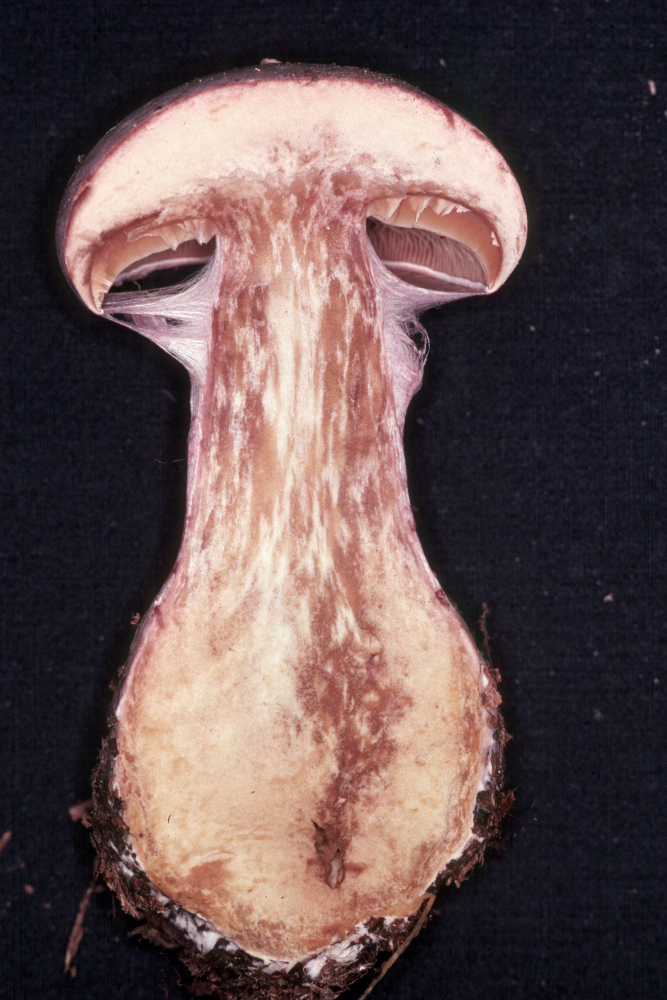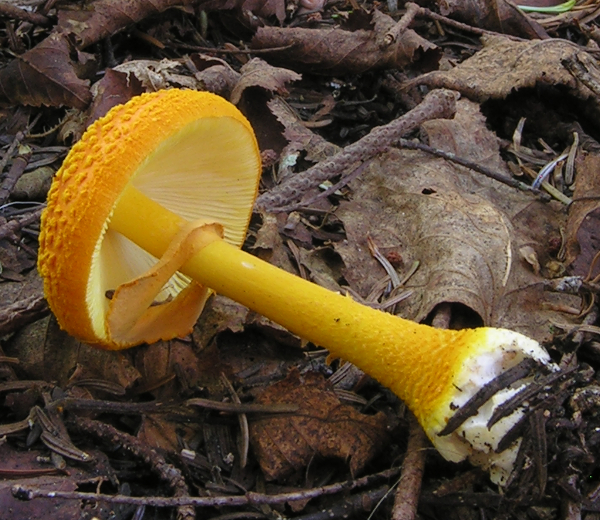ANNULUS OR CORTINA

Many mushrooms are enclosed by a covering or veil when they are in an early stage of development. The veil may entirely enclose both cap and stipe of the young mushroom and be called a universal veil. Other mushrooms may have a veil extending from the edge of the cap to the stipe, so that only the gills are covered. This type of veil is called a partial veil. many mushrooms have both partial and universal veils. The immature fruiting body of Cortinarius traganus, pictured at right, was split in half so that the veils could be seen. The universal veil covers the entire cap and extends down beyond the margin the form a covering arount the whole stipe. The partial veil also connects to the margin of the cap but does not extend down the stipe.

Veils are used extensively by mushroom enthusiasts as aids to identification. That's one reason why we always try to collect some very young fruiting bodies along with the more expanded mature ones. Mushrooms with clearly visible veils when young may show no sign of these when older. For example, we are pretty certain the mushroom at right belongs to the genus Cortinarius because of its cobwebby veils, referred to as a cortina (like a curtain). In fact, these are so characteristic of that genus that they are the origin of its name. With one or two very unusual exceptions, all species of the immense genus Cortinarius have a cortina.
When a mushroom is mature and expanded the veils become detached at the margin of the cap. The universal veil will still cover both cap and stipe but may have become so stretched-out as to be nearly invisible. In some cases the universal veil may be persistant as a cup or volva at the base of the stipe or as patches on the cap. The partial veil may remain as a fringe around the edge of the cap of may be seen on the upper part of the stipe as a ring of material. The nature of these remnants are imortant in mushroom identification.
The mushroom figured at left is Amanita flavoconia, one of our most beautiful, and most common, species. It is found in coniferous forests in summer and fall where it can be quite abundant. As with many species of Amanita, A. flavoconia has both universal and partial veils. The partial veil remains as an annulus, a membranous covering between cap margin and stipe that persists as a ring or skirt. In the photograph the annulus as remained attached to the pileus in one part so that it has torn away from the stipe. If the mushroom had not been dug up the annulus would soon have broken away from the cap and remained attached to the stipe.
The universal veil of A. flavoconia would originally have enclosed the whole fruiting body, but with expansion it can be seen as separate scales of material on the surface of the cap and lower stipe. In some Amanita species the universal veil is visible as a volva, but flakes off into the soil in A. flavoconia and many other species. When collecting species of Amanita it is helpful to note any remains of the universal veil in the soil around the base of the stipe.

The set of pictures at left illustrates some of the variation you may seem among the annuli of different mushrooms. The white-spored mushroom Armillaria ostoyae, at far left, has a rather thick annulus composed of distinct upper and lower parts. In contrast, Agrocybe acericola, second-from-left, has a very thin membranous annulus that tears easily and may remain partially attached to the edge of the cap. Gymnopilus voitkii, pictured second-from-right, and Leratiomyces squamosus, in the rightmost panel, have persistent and fairly sturdy annuli.

Species of Cortinarius and those of a few other genera have a cobwebby cortina instead of an annulus. Two species of Cortinarius, C. tortuosus in the near panal and C. evernius at far right, illustrate this. The picture of C. tortuosus shows four immature fruiting bodies, one cut in half. The sliced one is very similar to the similar section of C. traganus shown at the top of the page. Notice that the partial veil, the cortina proper, extends up from the edge of the pileus while the universal veil clearly extends down from the pileus and over the stipe. The three unopened caps show where the universal veil has torn and left the partial veil intact. Notice that even at this stage the universal veil is thinning out over the surface of the cap. At maturity it would be difficult to impossible to see any trace of either veil. Identification of Cortinarius species often requires knowing the colour of the cortina and universal veil, so it is important to collect very young speciemns along with mature ones. It should be added that mature specimens are necessary to obtain spores. Thus a good collection of a Cortinarius species contains as many stages of development as you can find.
The group of fruiting bodies of C. evernius at far right are more expanded than those of C. tortuosus. Nevertheless, the leftmost fruiting body (the one lying down) shows the cortina still connecting the cap with the stipe. In all of the fruiting bodies the universal veil is present on the cap only as a white marginal fringe. The thick cottony ring on the upper part of the stipe is actually the main remnant of the universal veil. Below it there are some thinner rings of this veil.

The final set of pictures are (L to R), an unidentified species of Tricholoma, Cystoderma amianthinum and Pholiota scamba. The Tricholoma and the Cystoderma both illustrate a common situation where the annulus is formed not from the partial veil but from the rupture of a particularly heavy and tough universal veil. Here the universal veil forms a stocking-like sheath over the lower part of the stipe and ends where it has broken away from the cap, leaving a flaring, funnel-like terminus on the stipe and, in the Cystoderma, a toothed fringe on the cap. Strictly speaking this is not an annulus, although many books will call it that. Such a sheathing veil, whether flaring at apex or not, is said to be peronate on the stipe.
Pholiota scamba is one of the smallest species in its genus. We often find it attached to small conifer twigs in moss carpets. It is included here because of the subtle ring on the upper part of the stipe. It is too sparse to be called an annulus but is an important feature of the species. It is impossible to tell from the picture whether this ring came from a partial or universal veil, but its presence shoud be noted in your description of your collection.